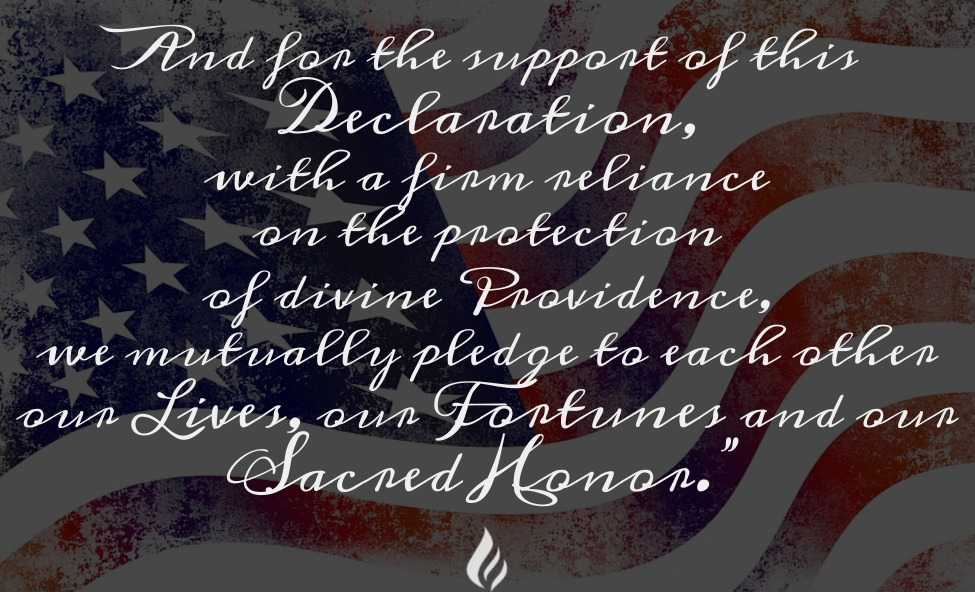Mark Cole
One of the permanent items at Monticello in Jefferson’s study near his bedroom was a bust of John Adams. Completely appropriate, one might think. The two men were essentially teammates during the founding era. Just as Washington kept gifts from Lafayette near him at Mt. Vernon, Jefferson would obviously like to be reminded of John Adams.
But as one becomes familiar with the life of Jefferson and Adams and their intense rivalry, it becomes not only less than obvious that Jefferson would like to see Adams likeness on a daily basis, it actually becomes quite shocking that Jefferson kept a bust of Adams near him. One is almost inclined to disbelieve it – that is, until one sees it for oneself (the bust of Adams holds court still today in Monticello).
The reason being that Jefferson and Adams – arguably the two most important signers of the Declaration and the only two signers who became President – were more often at each other’s throat than united.
There were only two stages in their long lives when Jefferson and Adams were not passionate competitors. During the run up to the Declaration they enjoyed camaraderie and friendship. This unity was disrupted by an era of backstabbing and political posturing which would last for roughly twenty years.
Finally, late in life, after both men were finished holding high offices, the two giants once again rekindled their friendship through a long series of remarkable letters, many of which were preserved for posterity and which are a true landmark of American history and literature.
It could have been much worse. A few twists of fate here or turns of destiny there and conceivably it could have been Jefferson and Adams who fought a duel, not Hamilton and Burr.
But the good times between the men were very good. Of the committee of five who drafted the Declaration, the task should have gone to the world-famous Benjamin Franklin. But he was not in perfect health and it was agreed that Franklin would better serve as an editor rather than a draftsman.
Adams, having already compiled an extraordinary record as the Atlas of Independence, probably then should have taken up the pen. But Adams, in a truly statesmanlike gesture, suggested Jefferson. Jefferson, apparently out of respect for Adams, declined until Adams insisted (correctly) that Jefferson was ten times the writer that he was.
With that, Jefferson accepted. And Adams very capably orally advocated the Declaration before the Continental Congress. He was, after all, a much better speaker than Jefferson. Never again would the two men defer to each other in such a way.
Together, then, Jefferson and Adams signed the Declaration. The two men most responsible for the Declaration and the substance of the Declaration were on that day in lockstep united when they pledged their lives, fortunes and sacred honor to the cause of American liberty.
From that day forward, the clashes between Adams and Jefferson were frequent and intense. Under George Washington, Adams served as Vice President while Jefferson was Secretary of State but the two had very different political philosophies and very different attitudes towards the French Revolution.
When Jefferson left the Washington administration at the end of 1793, it was to set up his run for the Presidency against Adams. In the election of 1796, Adams received 71 electoral votes and Jefferson received 68. Federalist Adams thus became President, and Democrat Republican Jefferson, as the runner-up, became Vice President as then provided by the Constitution.
The election of 1800 was a re-match, with Vice President Jefferson seeking to oust President Adams. It was a re-match for blood. Federalist newspapers declared that a Jefferson presidency would flood the nation with teachings of “murder, robbery, rape, adultery and incest.” Democrat Republicans were routinely denounced as “Jacobins.”
The Democrat Republicans, not to be outdone, focused their wrath not in particular on Adams (who was actually estranged from the Federalist Party structure and was an icon of the founding era), but on Hamilton. From the democratic perspective, Hamilton was an easy target. He was reviled as a would-be monarch, a royalist, a slave to his lusts, an aristocrat who (it was asserted) frequented brothels.
If the Democrat Republicans were the party of the Jacobins, then the Federalists were the party of Louis XVI (or perhaps Nero and Caligula).
The election was extremely close and the electoral votes were indecisive. The top two electoral vote-getters were Jefferson and Aaron Burr. The election was thrown to the U.S. House of Representatives and after a long deadlock, Jefferson narrowly triumphed – ironically with the back room support of Alexander Hamilton who thought that Jefferson was the lesser of the two evils.
(Hamilton’s maneuvers kept Aaron Burr from obtaining the Presidency and further intensified the hatred between the two men. Their rivalry would only end in 1804 with their duel and Hamilton’s death).
Thus, Thomas Jefferson, author of the Declaration of Independence, by vanquishing the Atlas of Independence John Adams, became the Third President of the United States.
Adams was forced into retirement, skipped his rival’s inauguration (where Jefferson made an appeal for the parties to seek common ground) and had no communication with Jefferson for the next twelve years.
Jefferson went on to a spectacularly successful presidency, which included the Louisiana Purchase, a reduction in taxes, a workable plan to retire the public debt, a build up of the U.S. Navy, and an overwhelming re-election in 1804. His administration is regarded as one of the most successful in U.S. history. And it is Jefferson the President who joins Washington, Lincoln and Theodore Roosevelt on Mt. Rushmore. One of our most important patriots thus became one of our most important Presidents.
Jefferson left the Presidency in 1809 and went on to found the University of Virginia. This undertaking took several years and the first students finally arrived in 1825. His lifelong attention to detail was in full force during the project. Jefferson conceived the vision for the University, oversaw the hiring of the first faculty, designed the first buildings and supervised their construction.
Until shortly before his death, he hosted Sunday evening dinners for the students at Monticello. To this day, the University of Virginia is understood to be Jefferson’s university.
The rightly famous Jefferson-Adams correspondence commenced in 1812, and lasted until the two men died within hours of each other on July 4, 1826, exactly 50 years to the day after the Declaration of Independence was adopted.
Jefferson’s final words were, “Is it the fourth?”
It has been said that as a messenger was arriving at Quincy to tell Adams of Jefferson’s passing, he passed a messenger leaving with the message to Monticello that Adams had died.
***
Monuments to Thomas Jefferson today dot the American landscape: the towering Jefferson memorial in Washington, D.C., Monticello, the University of Virginia, Mt. Rushmore, the Thomas Jefferson Building of the Library of Congress.
His image can be found on our two dollar bill and nickel. But his most enduring legacy is certainly his first great accomplishment, his authorship of the Declaration of Independence.
“We, therefore, the Representatives of the United States of America, in General Congress, Assembled, appealing to the Supreme Judge of the world for the rectitude of our intentions, do, in the Name, and by Authority of the good People of these Colonies, solemnly publish and declare,
That these United Colonies are, and of Right ought to be Free and Independent States; that they are Absolved from all Allegiance to the British Crown, and that all political connection between them and the State of Great Britain, is and ought to be totally dissolved; and that as Free and Independent States, they have full Power to levy War, conclude Peace, contract Alliances, establish Commerce, and to do all other Acts and Things which Independent States may of right do.
Get the entire Thomas Jefferson story, and so much more –
Check out Mark’s book:
Lives, Fortunes, Sacred Honor: The Men Who Signed the Declaration of Independence














